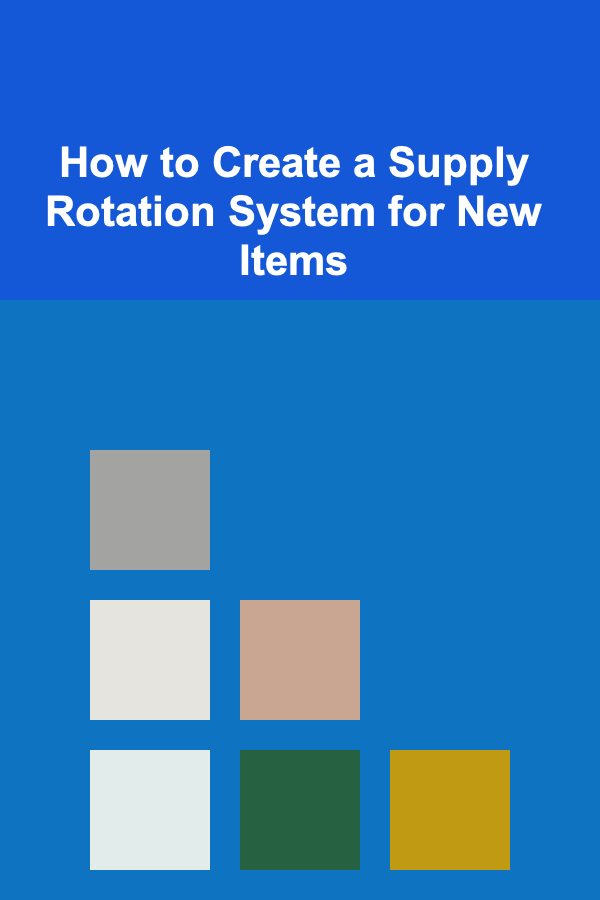
How to Create a Supply Rotation System for New Items
ebook include PDF & Audio bundle (Micro Guide)
$12.99$9.99
Limited Time Offer! Order within the next:

In any organization---be it a school, business, or home---efficient management of supplies is crucial for maintaining productivity and reducing waste. A supply rotation system allows you to effectively manage new items, ensuring that older supplies are used before they expire or become outdated. This comprehensive guide will explore how to create an efficient supply rotation system for new items, detailing the principles behind such systems, practical methods for implementation, and strategies for ongoing maintenance.
Introduction
Managing supplies effectively can be a challenging task, especially in environments with high turnover rates or rapidly changing stock. The introduction of new items must be carefully planned to ensure that they complement existing inventory and do not lead to waste. A supply rotation system provides a structured approach to managing this process, helping organizations utilize resources efficiently while minimizing losses.
This article aims to provide a step-by-step guide on creating a supply rotation system for new items, focusing on practical techniques and long-term sustainability.
Understanding the Importance of Supply Rotation
A well-implemented supply rotation system serves several important functions:
- Waste Reduction: Regularly rotating supplies ensures that older items are used before expiration, significantly reducing waste.
- Cost Efficiency: By maximizing the use of all supplies, organizations can minimize unnecessary purchases and associated costs.
- Enhanced Organization: A systematic approach to inventory management leads to better organization and easier access to materials.
- Improved Accountability: Tracking supplies systematically fosters a culture of responsibility, ensuring that team members are aware of their resource usage.
- Quality Assurance: Regularly using supplies helps maintain their quality, as many items degrade over time if left unused.
Assessing Your Inventory
Before implementing a supply rotation system, it's essential to evaluate your current inventory. Here are steps to conduct an effective assessment:
1. Create an Inventory List
Compile a detailed list of all supplies currently on hand, including quantities, expiration dates, and conditions. This list should be updated regularly to reflect new acquisitions and usages.
2. Categorize Your Supplies
Group similar items together to facilitate organization and management. Common categories may include:
- Office Supplies (e.g., paper, pens)
- Cleaning Supplies (e.g., detergents, disinfectants)
- Food Items (e.g., canned goods, perishables)
- Educational Materials (e.g., textbooks, stationery)
3. Evaluate Usage Patterns
Analyze which items are frequently used and which tend to sit unused for extended periods. Understanding these patterns will inform your rotation strategy.
Designing Your Supply Rotation System
Once you've assessed your inventory, it's time to design a rotation system tailored to your needs.
4.1 Establishing Categories
Clearly define categories within your inventory system based on the type of supplies, frequency of use, or expiration date.
- High Turnover vs. Low Turnover: Differentiate between items that are used regularly and those that are less frequently utilized.
- Expiration Dates: Prioritize items with shorter shelf lives to prevent waste.
4.2 Implementing the First In, First Out (FIFO) Method
The FIFO method is a widely-used inventory management principle that ensures the oldest items are used first:
A. How It Works
- New Arrivals: Place new items behind older ones on shelves or in storage areas.
- Access Points: Ensure that the most accessible items are also the oldest in stock.
B. Benefits of FIFO
- Minimizes Waste: Reduces the risk of items expiring unnoticed.
- Encourages Efficiency: Streamlines the process of selecting supplies, reducing time spent searching for materials.
4.3 Labeling and Tracking
Effective labeling and tracking systems are essential for maintaining a successful supply rotation:
A. Labeling Supplies
- Expiry Dates: Clearly label each item with its expiration date.
- Purchase Dates: Consider adding the purchase date for additional context.
B. Digital Tracking
Utilize spreadsheets or inventory management software to keep track of supplies:
- Column Fields: Include fields for item name, quantity, location, purchase date, and expiration date.
- Alerts: Set up alerts for items approaching expiration to prompt timely usage.
Organizing Your Space for Effective Rotation
An organized space is critical for a functional supply rotation system. Here are some strategies to optimize your area:
1. Use Clear Storage Bins
Using clear bins allows for quick identification of supplies. Ensure that they are labeled according to category and organized by expiration date.
2. Shelving Systems
Install shelving units to maximize vertical space. Arrange items from oldest to newest based on expiration or purchase date.
3. Accessibility Considerations
Place frequently used items at eye level and easily reachable locations, while less commonly used items can be stored higher or deeper in storage.
4. Color Coding
Implement color coding on labels or bins to visually differentiate categories. For example:
- Red for Expired Items
- Green for Non-perishables
- Yellow for Cleaning Supplies
Maintaining Your Supply Rotation System
Creating a supply rotation system is just the beginning; consistent maintenance is vital for its effectiveness:
1. Regular Audits
Conduct regular audits of your inventory to ensure compliance with the rotation system:
- Schedule: Perform audits monthly or quarterly, depending on the complexity of your inventory.
2. Adjustments Based on Usage
Be adaptable. If certain items are moving faster or slower than anticipated, make adjustments to the rotation method accordingly.
3. Team Involvement
Foster a culture of accountability among team members regarding supply rotation. Provide training on how to properly rotate supplies and why it's important.
4. Documentation
Keep records of audits, changes made to the inventory, and any other relevant documentation to track the effectiveness of your system.
Common Challenges and Solutions
Despite the best-laid plans, challenges may arise in maintaining a supply rotation system. Here are common issues and how to address them:
1. Stockpiling
Challenge: Individuals may hoard supplies, leading to imbalance in usage and potential waste.
Solution: Monitor usage patterns closely and set limits on how much of a particular item can be stored.
2. Mislabeling
Challenge: Incorrect or unclear labeling can lead to confusion about expiration dates.
Solution: Use standardized labels and conduct periodic checks to confirm accuracy.
3. Overlooked Items
Challenge: Some items may be forgotten if they are placed in hard-to-reach areas.
Solution: Regularly review the entire inventory and consider rotating the placement of seldom-used items to increase visibility.
4. Insufficient Training
Challenge: Team members may not understand the importance of the supply rotation system.
Solution: Provide comprehensive training sessions highlighting the benefits and procedures of the rotation system.
Conclusion
Creating a supply rotation system for new items is an essential practice for minimizing waste and maximizing efficiency in any organization. By understanding the importance of supply rotation, assessing your inventory, designing a tailored system, and maintaining it diligently, you can ensure that your resources are used effectively.
Incorporating best practices such as the FIFO method, strong labeling, and digital tracking will further enhance your supply rotation system. Commitment to regular audits and adjustments, along with fostering a culture of responsibility among team members, will solidify the success of your organization's supply management efforts.
Take action today to implement a supply rotation system, and witness the positive impact it has on your operational efficiency and resource sustainability!

Cost Accountant Essentials: Tools and Tactics for Effective Cost Control
Read More
How to Master Ethical Leadership
Read More
How to Maximize Small Spaces for Pet Organization
Read More
How to Organize Your Car with Reusable Bags and Containers
Read More
How to Pack for a Volunteering Trip: A Checklist for a Meaningful Journey
Read More
How to Use Repurposed Items for Unique Bathroom Storage
Read MoreOther Products

Cost Accountant Essentials: Tools and Tactics for Effective Cost Control
Read More
How to Master Ethical Leadership
Read More
How to Maximize Small Spaces for Pet Organization
Read More
How to Organize Your Car with Reusable Bags and Containers
Read More
How to Pack for a Volunteering Trip: A Checklist for a Meaningful Journey
Read More